Sir Gawain and the Green Knight
18 April - By Mr. Underhill
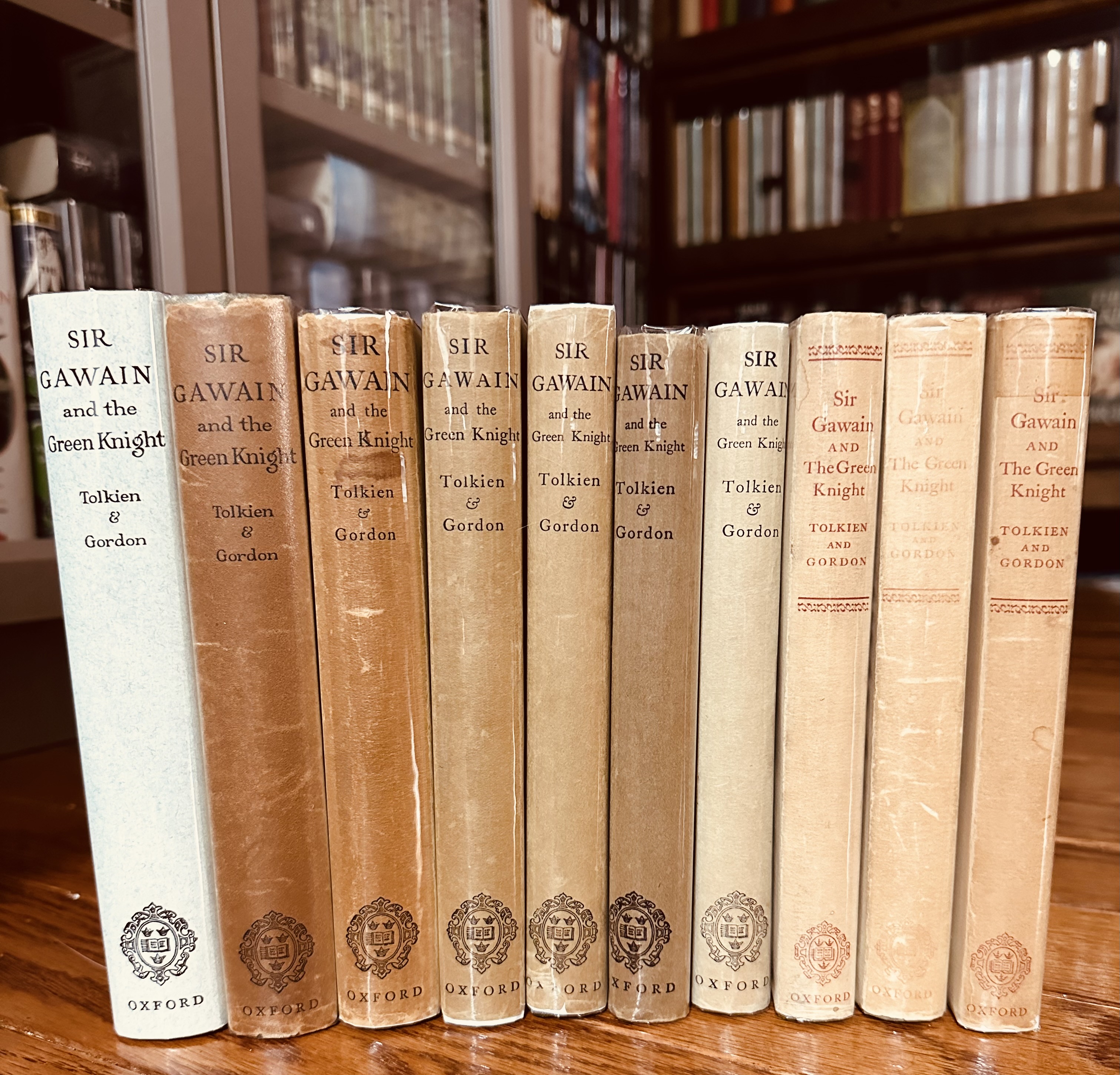
All printings of the 1st Edition w/ Jackets
This article is an introduction to Sir Gawain and the Green Knight, edited by JRR Tolkien and EV Gordon. It was first published by the Oxford University Press in 1925. These volumes of Sir Gawain and the Green Knight are scholarly editions of the Middle English romance. Tolkien was responsible for the glossary and for the text of the poem, while Gordon produced the majority of the accompanying notes. This article does not cover Tolkien's translation of the story into modern English, which was first published in 1975, there are some accompanying images of variants of those volumes at the end of this article however.
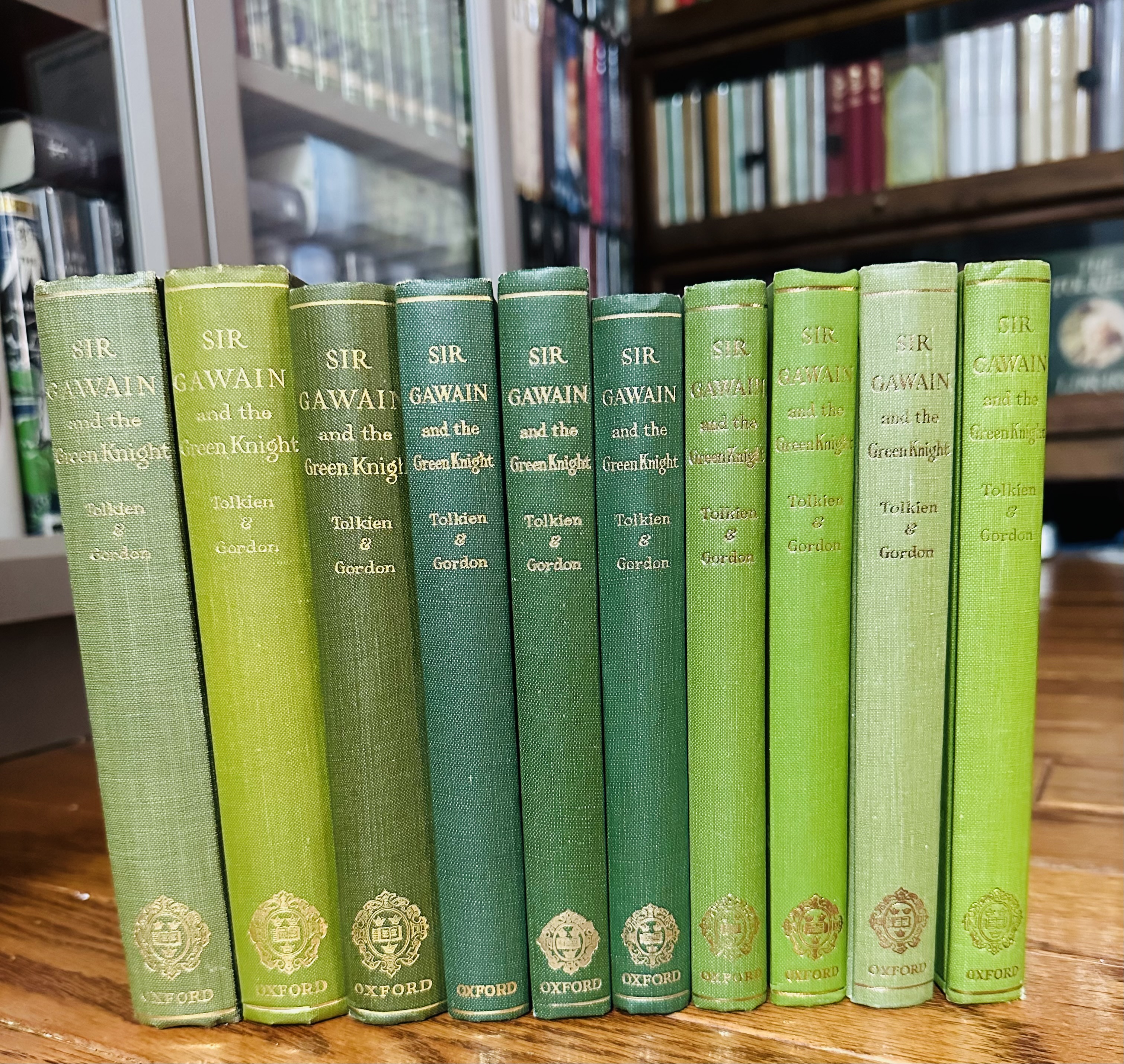
All printings of the 1st Edition without Jackets
Sir Gawain and the Green Knight is a late 14th-century chivalric romance in Middle English alliterative verse. The author is unknown; the title was given centuries later. It is one of the best-known Arthurian stories, with its plot combining two types of folk motifs: the beheading game, and the exchange of winnings. Written in stanzas of alliterative verse, each of which ends in a rhyming bob and wheel, it draws on Welsh, Irish, and English stories, as well as the French chivalric tradition.
It is an important example of a chivalric romance, which typically involves a hero who goes on a quest which tests his prowess. It remains popular in modern English renderings from J. R. R. Tolkien, and others, as well as through film and stage adaptations.
The story describes how Sir Gawain, who was not yet a knight of King Arthur's Round Table, accepts a challenge from a mysterious "Green Knight" who dares any man to strike him with his axe if he will take a return blow in a year and a day. Gawain accepts and beheads him, at which point, the Green Knight stands, picks up his head, and reminds Gawain of the appointed time. In his struggles to keep his bargain, Gawain demonstrates chivalry and loyalty until his honour is called into question by a test involving the lord and the lady of the castle at which he is a guest.
The poem survives in one manuscript, Cotton Nero A.x., which also includes three religious narrative poems: Pearl, Cleanness, and Patience. All four are written in a North West Midlands dialect of Middle English, and are thought to be by the same author, dubbed the "Pearl Poet" or "Gawain Poet".
1925 1st Printing
2,500 copies printed. Page edges untrimmed. Contains a tissue guard on the title page, and errata slip towards the front of the book.
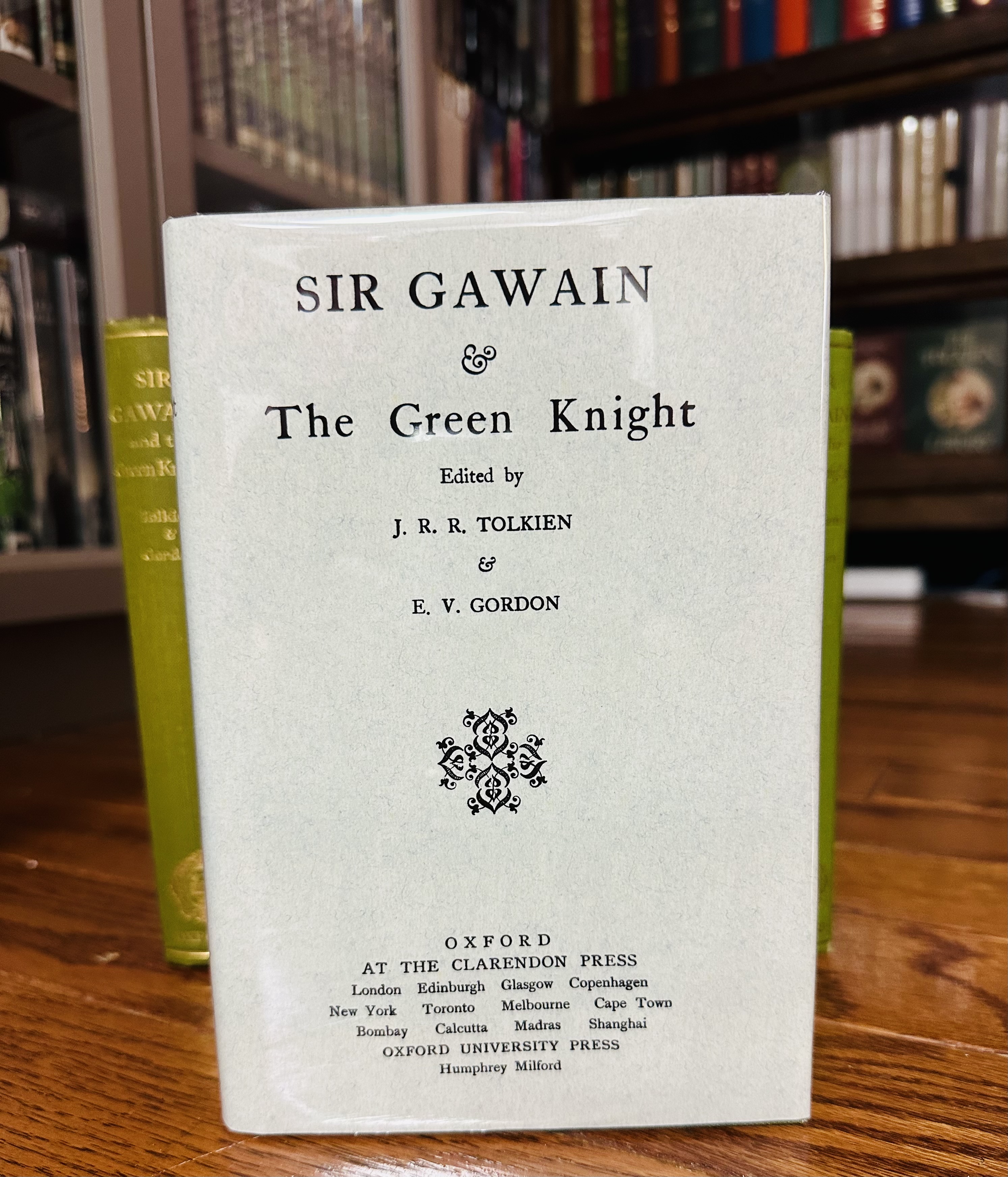

1925 Edition, Facsimile Jacket
Stamped ax ornament and border on upper board are in gilt. Logo present on spine of binding.


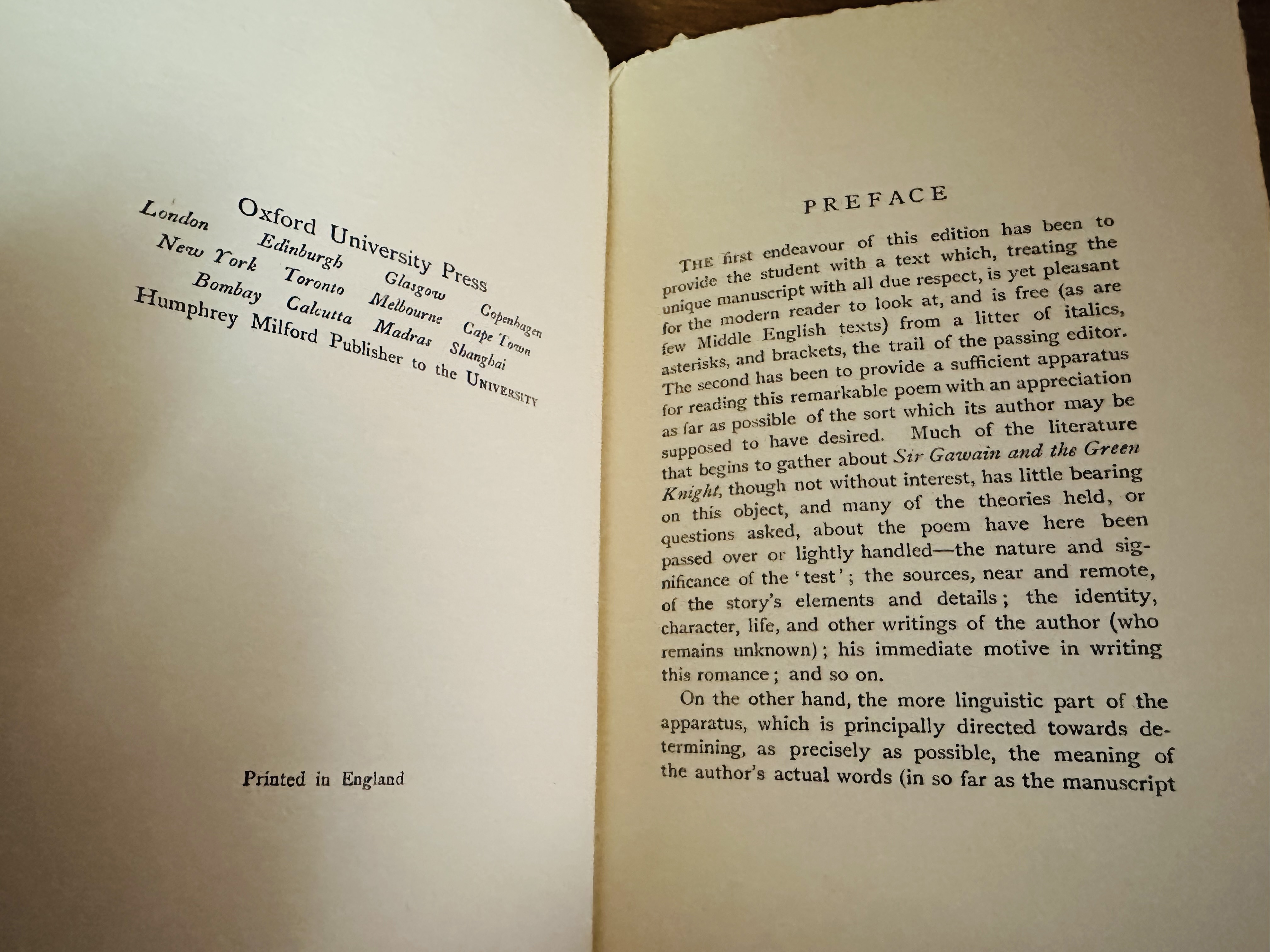
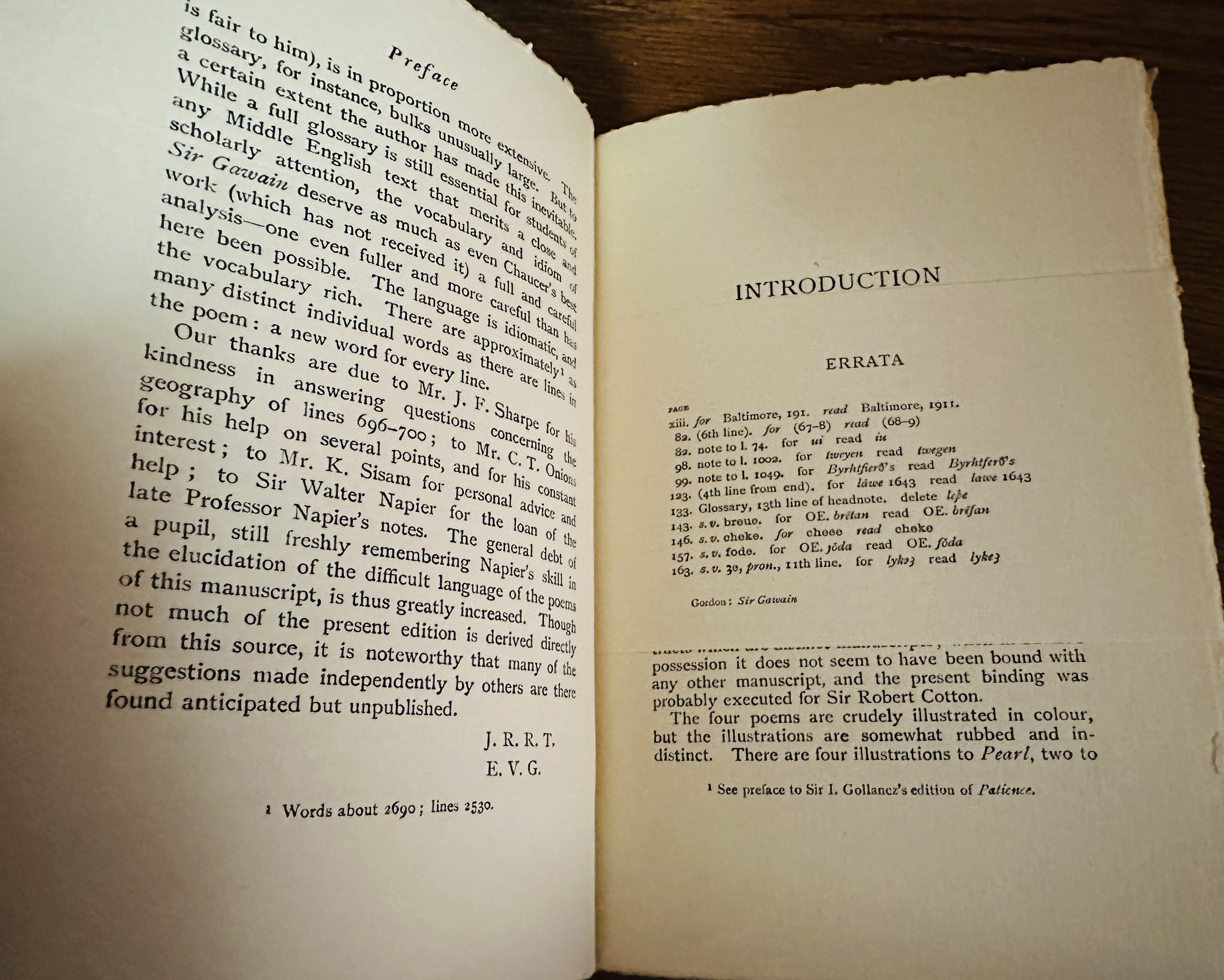
1925 Edition
1930 2nd Printing
Corrected edition. Variants have been seen both with and without tissue guards over the plates. This one is one without a tissue guard. Nearly same dimensions as the 1st printing.
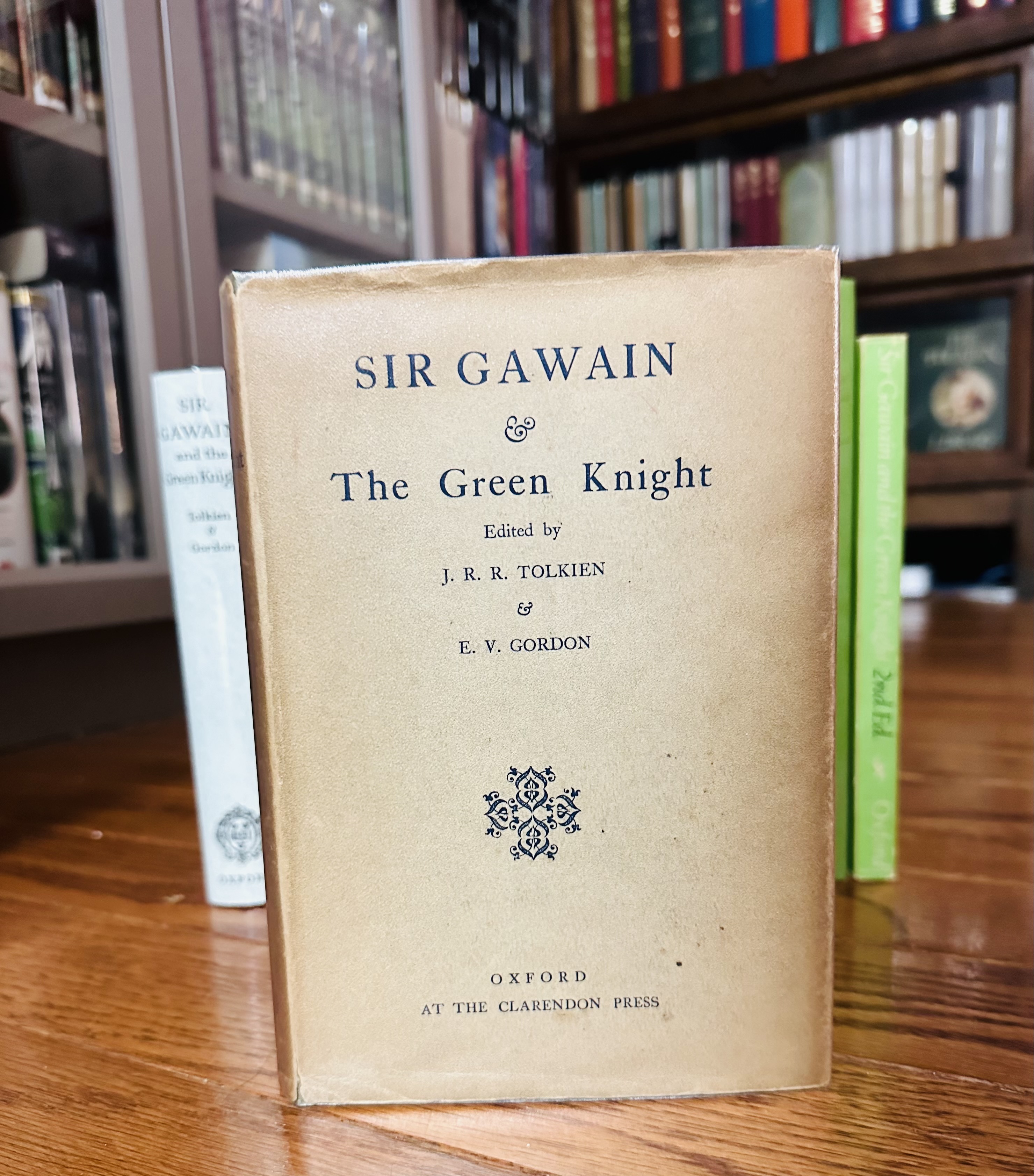

1930 Edition
Variants have been seen both with and without the top edges of the pages trimmed. Stamped ax ornament and border on upper board are in gilt. Logo present on spine of binding.

1930 Edition
1936 3rd Printing
Size reduced somewhat. Top edges of pages trimmed.
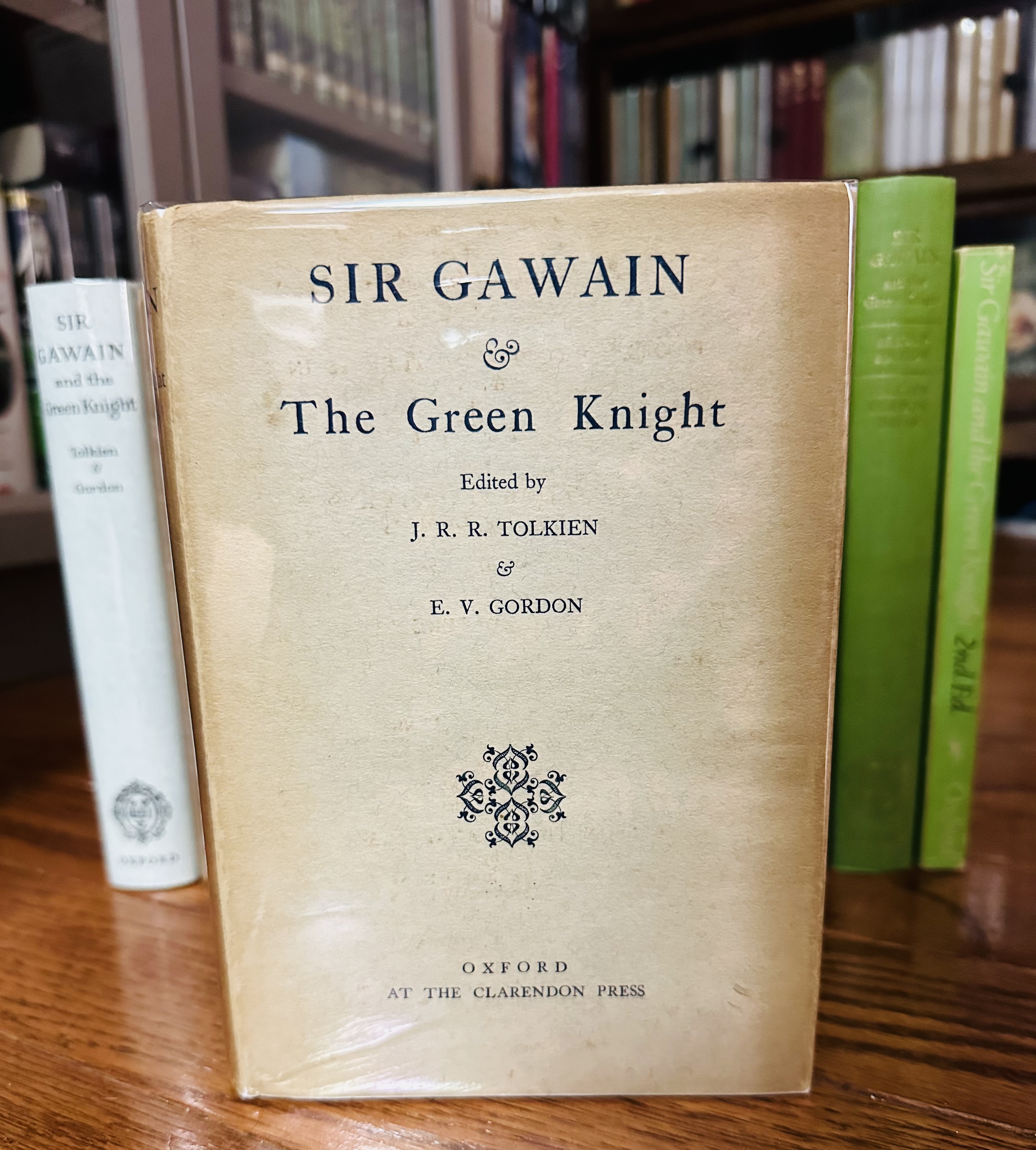
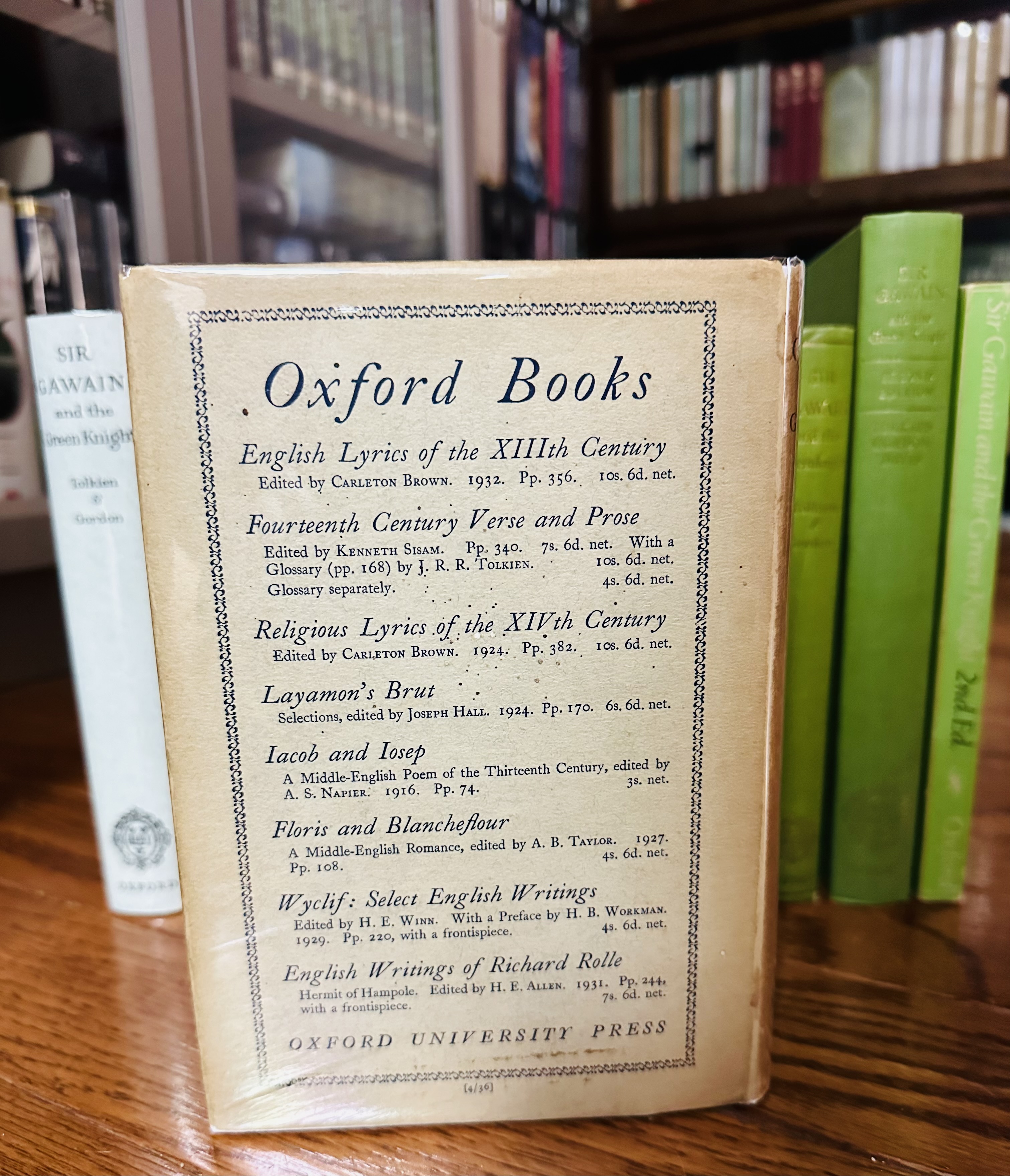
1936 Edition
Stamped ax ornament and border on upper board are plain, very difficult to see in lower light. Logo present on spine of binding
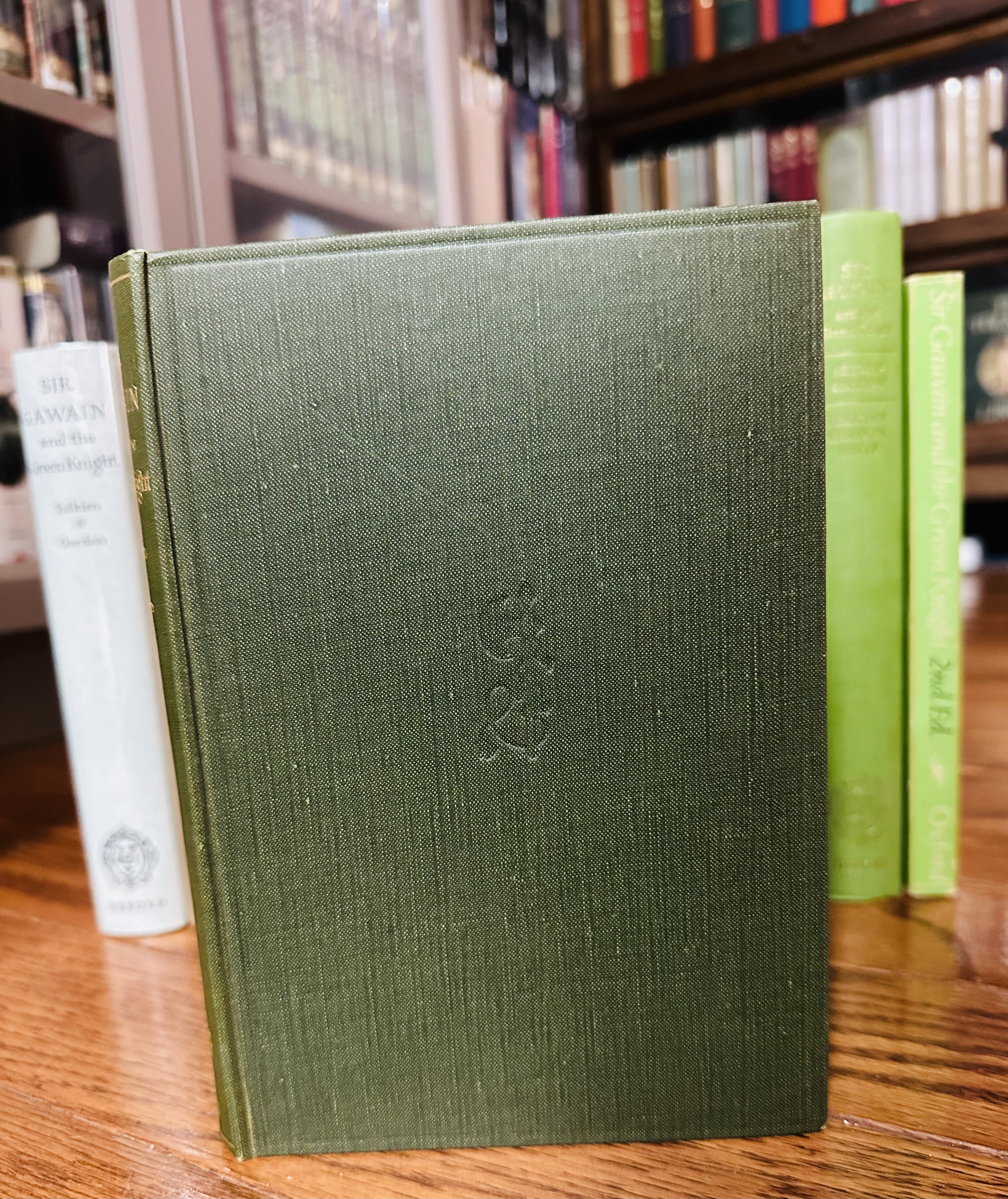
1936 Edition
1946 4th Printing
Size reduced even further, most likely printed to Britain’s postwar economy standard. Top edges of pages trimmed. Back of the dust jacket altered.
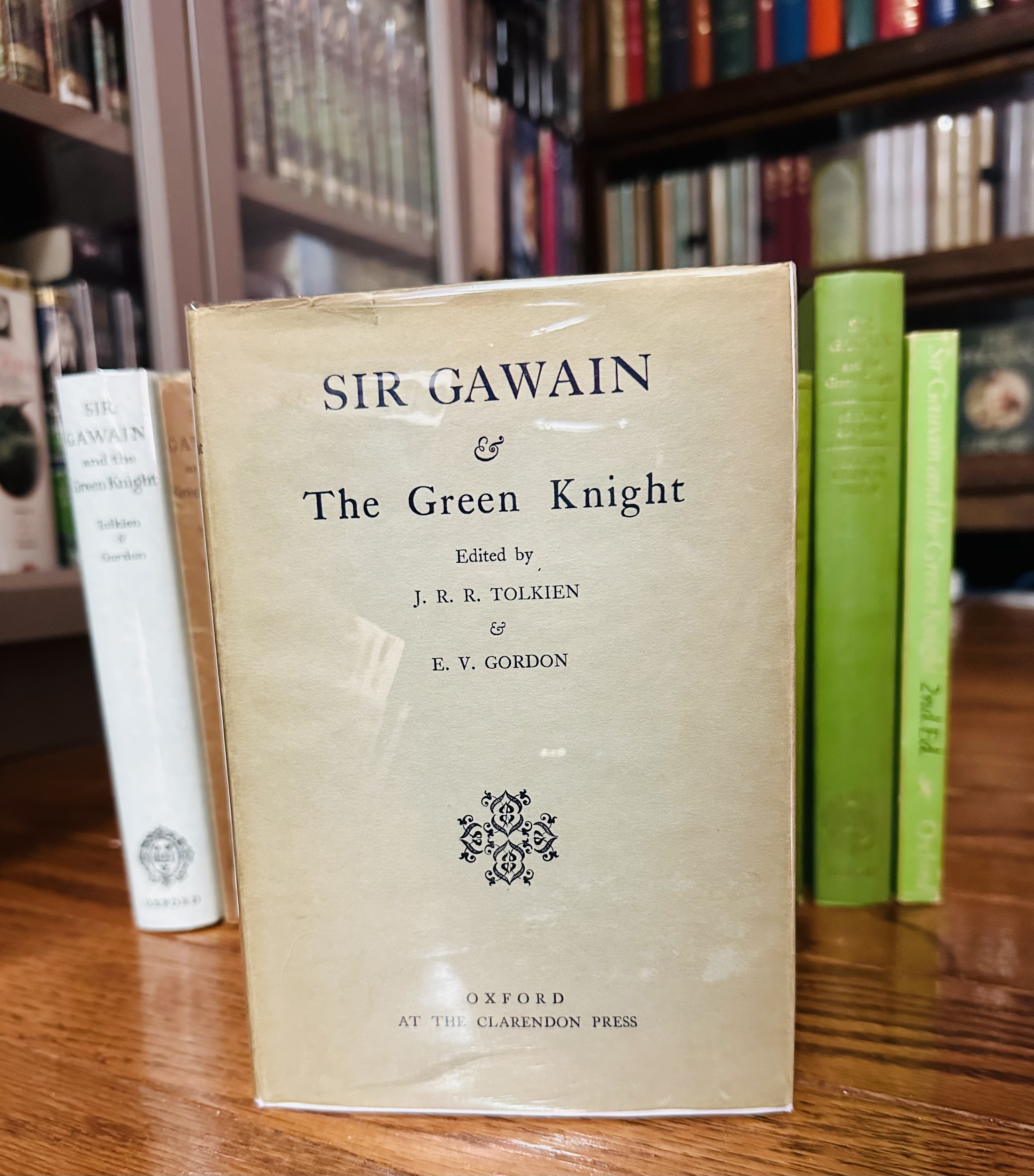
1946 Edition
No stamped ax ornament or border on upper board. Variants have been seen with and without logo on spine of binding.
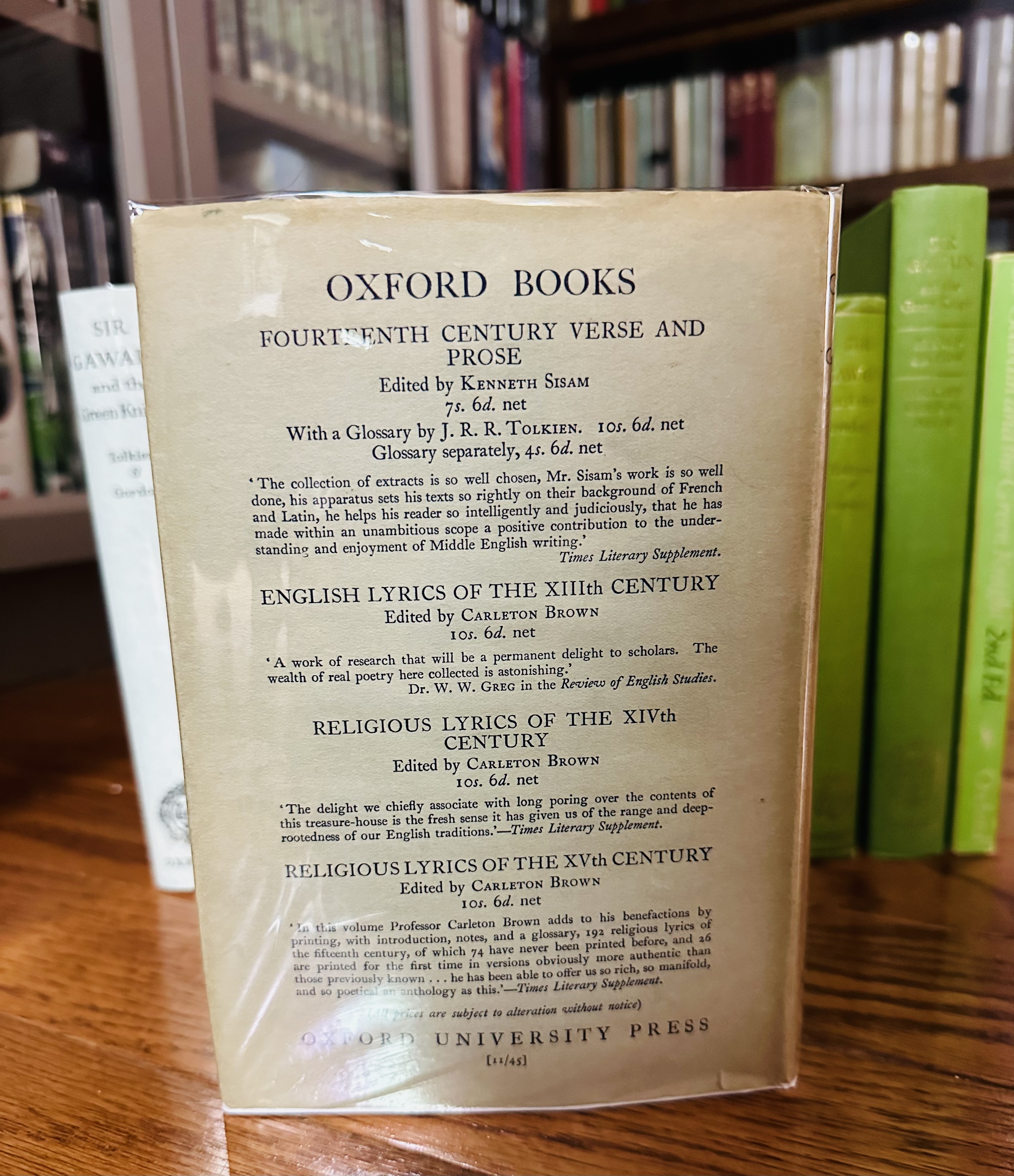
1946 Edition
1949-1955 5th - 7th Printings
Top edges of pages trimmed. No stamped ornament or border on upper board.
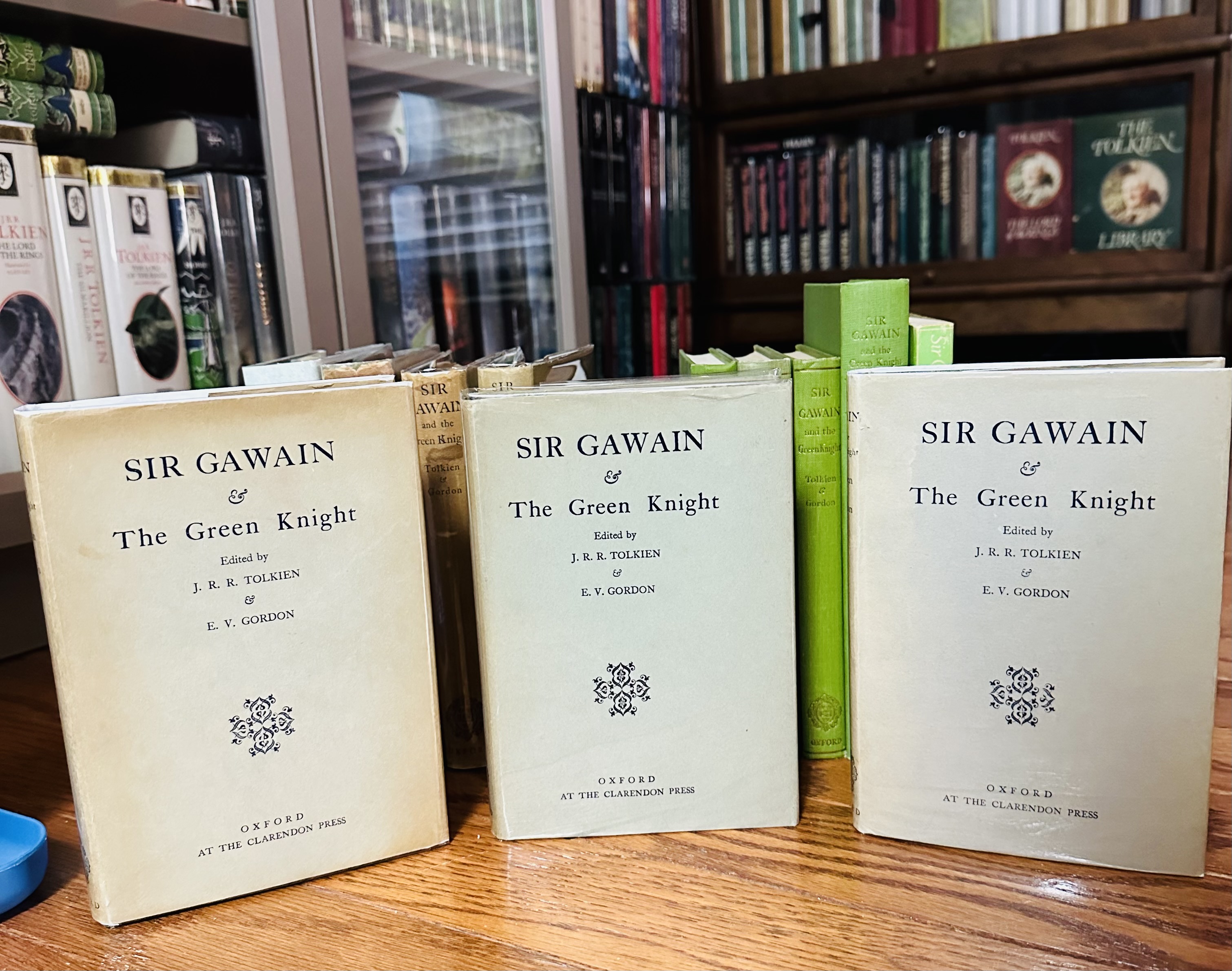
1949, 1952, & 1955 Editions
Logo present on spine of binding. Much smaller and thinner than the earlier printings and for the most part uniform.
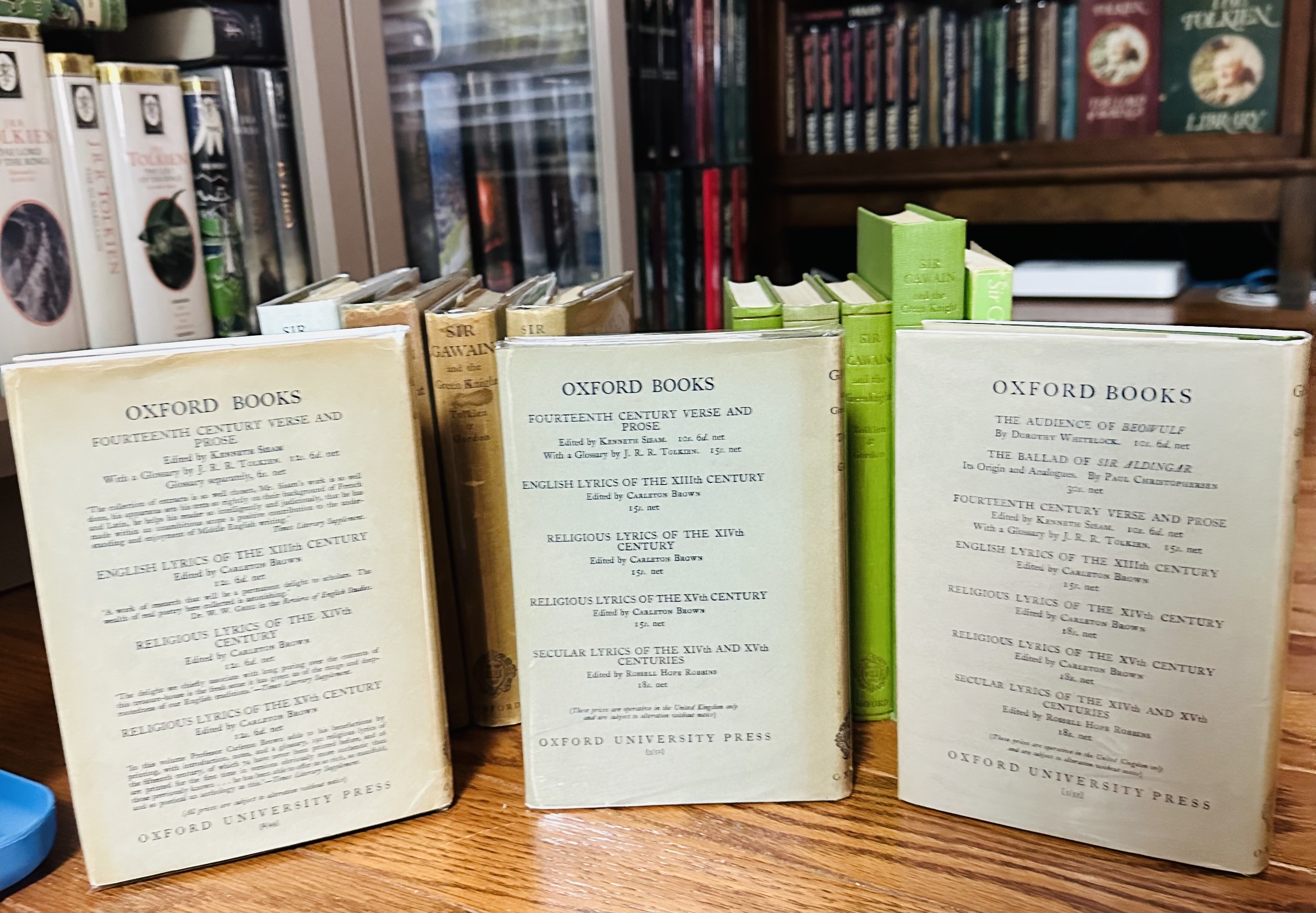
1949, 1952, & 1955 Editions
1960-1966 8th - 10th Printings
All page edges trimmed. No stamped ornament or border on upper board. Boards varying shades of green.

1960, 1963, & 1966 Editions
Logo present on spine of binding. Dust jacket completely redesigned.
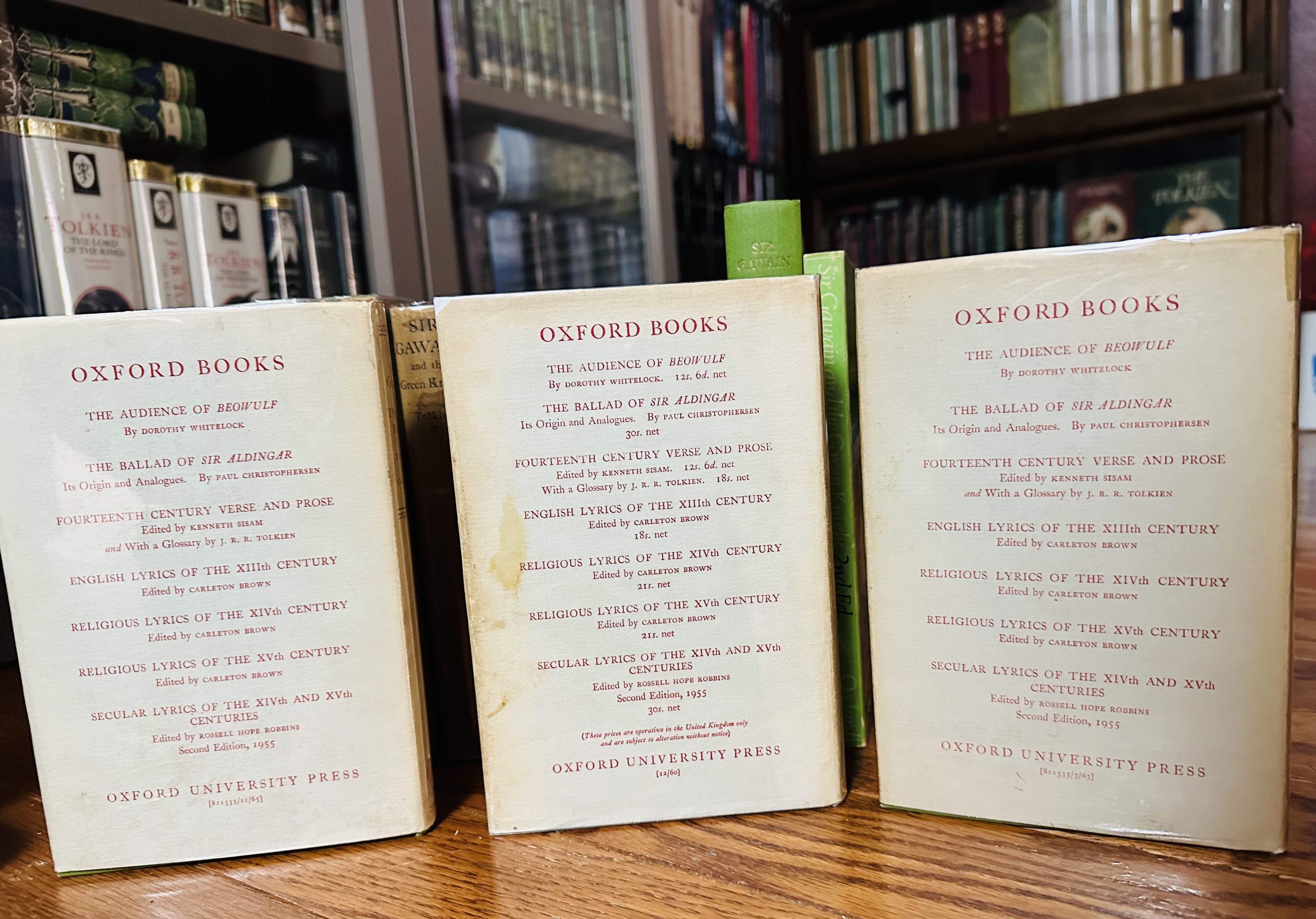
1960, 1963, & 1966 Editions
2nd Edition Hardback and Paperback

1967 Hardback & 1968 Paperback Editions
Using a number of sources of information, including Tolkien's later notes on the subject, Norman Davis revised Tolkien and Gordon's earlier work - largely rewriting the Introduction, Notes and appendices on Metre and Language in the process.
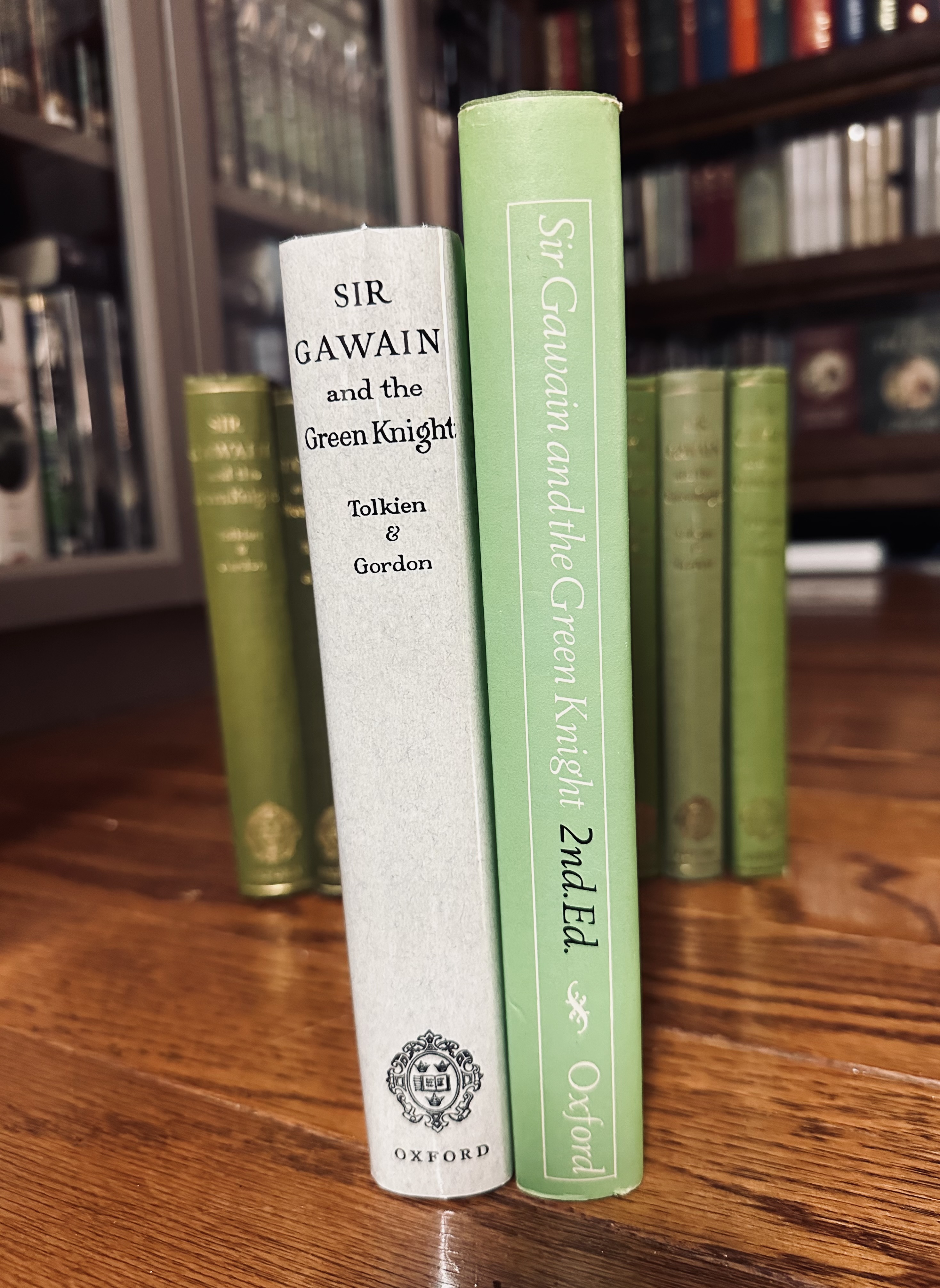
1967 2nd Edition next to 1925 1st Edition
Reprinted many times
The size of the book (but not the text) was reduced for the paperback volumes as well as some reprints of the hardback volumes but just how many times these were produced is unclear. According to tolkienbooks.net this volume was being reprinted well into the 1990s.
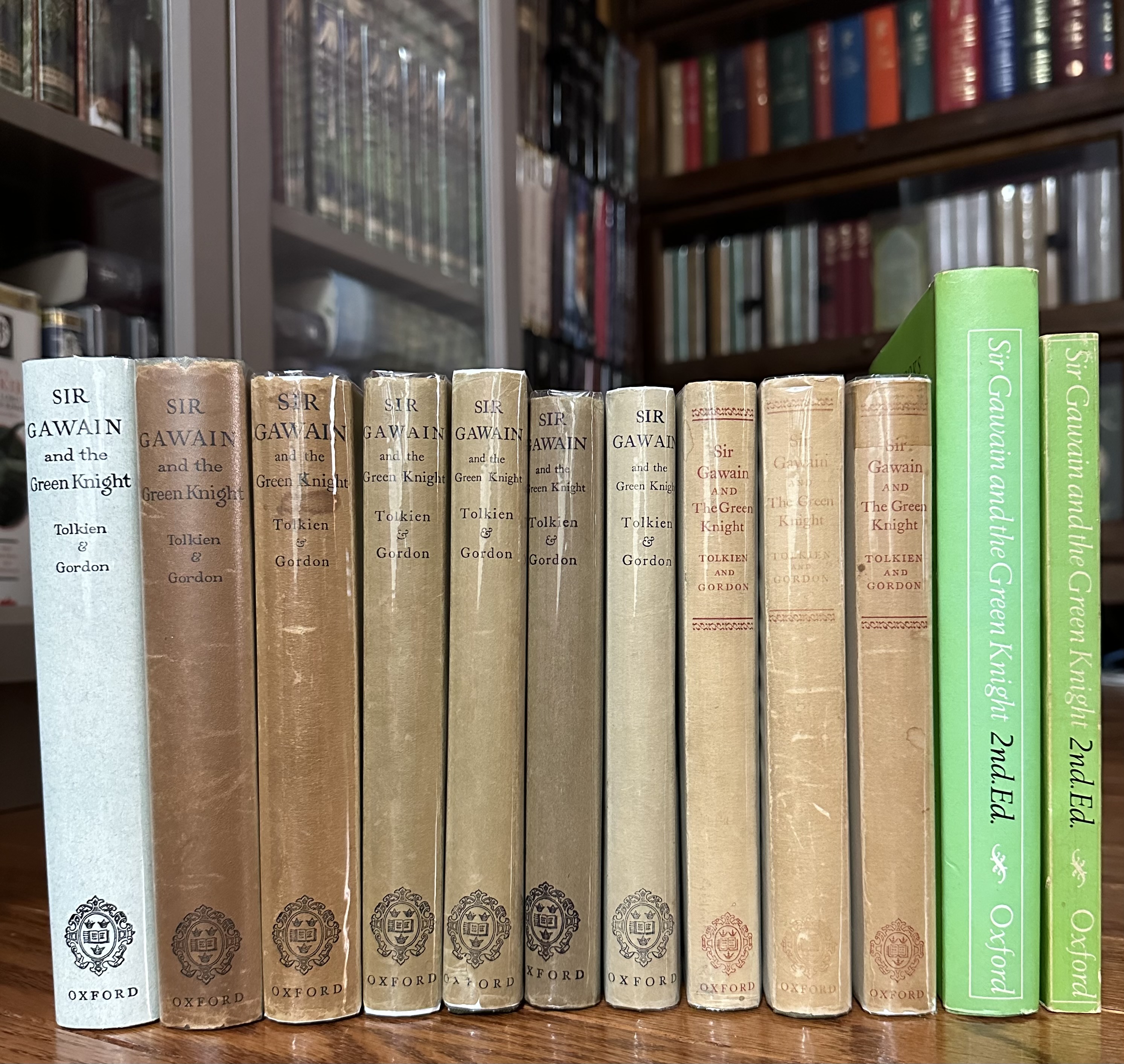
All Editions w/ Jackets
Size of the book much enlarged and dustjacket completely redone in design for this new hardback edition.

All Editions without Jackets
Translation into modern English

1975 GA&U and HMCO Editions with the 2020 HC Deluxe Edition
Edited by Christopher Tolkien and published in 1975 together with Pearl, and Sir Orfeo. This was the first of his father's works that Christopher prepared for publication after Tolkien's death in 1973. I have included just a few variants, but it is not an exhaustive list. That article will have to wait for another day


Various Paperback Editions
All images from the collection under The Hill
For more information
1. J.R.R. Tolkien A Descriptive Bibliography - Wayne G. Hammond with the assistance of Douglas A. Anderson (Oak Knoll)
2. Deagol's Site - Tolkienbooks.net
TCG YouTube Video on Sir Gawain
Sir Orfeo
15 April - By Trotter
Sir Orfeo

Cover of the 1944 pamphlet - Image from the Bodleian Library, Oxford
The plot is very familiar to Tolkien readers. Sir Orfeo is the King, whose wife disappears. He leaves his kingdom to try and find her, and travels to Faerie. He finds his wife and travels back to his kingdom.
It cannot be said where or when Sir Orfeo was composed with any more precision than probably in the south-east of England in the latter part of the thirteenth century, or early in the fourteenth; and it seems at any rate more probable than not that it was translated from a French original.
Sir Gawain and the Green Knight, Pearl, Sir Orfeo by J.R.R. Tolkien and edited by Christopher Tolkien
1944 edition
This is a very rare publication, and to date only five copies are known to exist. The small number of surviving copies may be down to the fact that Tolkien's name does not appear on the pamphlet.
A note inside the Bodleian Library copy indicates that the booklet was reproduced by the University (by mimeograph) before the text, set for English Schools, was formally printed from type. However, the booklet seems to have been the only printing of this text. Another copy, in the English Faculty library at Oxford, contains a note, reported to be in Tolkien's hand, which states that this edition of 'Sir Orfeo' was prepared for the navel cadets' course in English, which Tolkien organized in January 1943 and directed until the end of March 1944.
J.R.R. Tolkien A Descriptive Bibliography Wayne G. Hammond with the assistance of Douglas A. Anderson B18
Fortunately, Tolkien Studies Volume 1 (2004) has an article Sir Orfeo: A middle-English Version By J.R.R. Tolkien (Carl F. Hostetter), which contains the whole of Tolkien's transcription and his notes from the pamphlet, along with some excellent background to the poem. A highly recommended read.
In the MS. Tolkien A33/1 (1) Folios i - 22 at the Bodleian Library are the notes and some typed pages of Tolkien's middle-English version of the poem. The printed notes at the end of the pamphlet are typed in italics. The typed version includes line numbers but the printed pamphlet does not include the line numbers, so was possibly not proofed by Tolkien, as he needed the line numbers to talk about the poem. The numbers were pencilled in or Tolkien's copy.
There are some typed notes on the back of one page of the original typed manuscript, which give an indication that Tolkien may not have liked the poem as much as other middle-English poems.
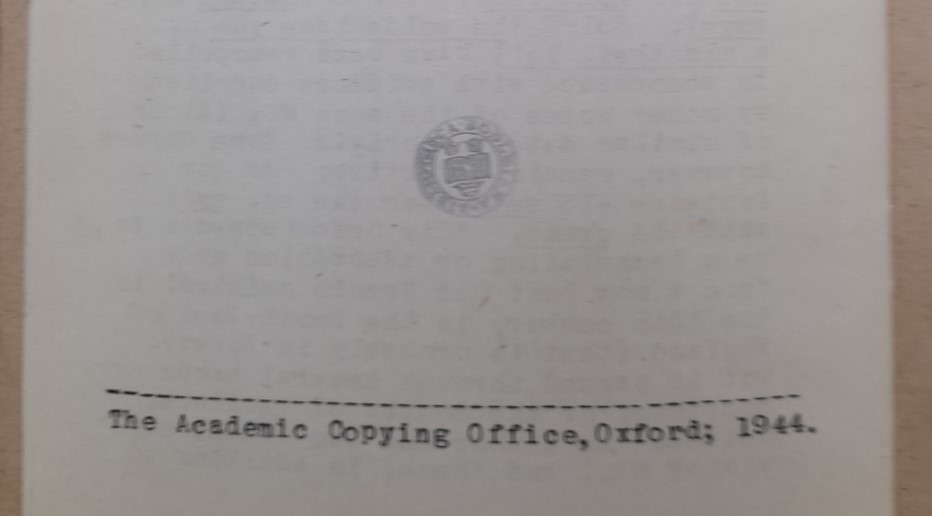
Academic Copying Office, Oxford - Image from the Bodleian Library, Oxford
A.J. Bliss 1954 edition
An edition of Sir Orfeo was published in 1954 edited by Alan Bliss as part of Oxford English Monographs series of which J.R.R. Tolkien was a general editor. Bliss also thanks Tolkien for his assistance in the book.


Sir Orfeo A.J. Bliss London: Oxford University Press - From the Library of Mr. Underhill
1975 edition

Proof edition of Sir Gawain and the Green Knight, Pearl, Sir Orfeo by J.R.R. Tolkien and edited by Christopher Tolkien - George Allen & Unwin 1975
In 1975 George Allen & Unwin published Sir Gawain and the Green Knight, Pearl and Sir Orfeo by J.R.R. Tolkien and edited by Christopher Tolkien.
In the Preface
His version of Sir Orfeo was also made many years ago, and had been (I believe) for long laid aside; but he certainly wished to see it published.
I was not able to discover any writing by my father on the subject of Sir Orfeo. Here therefore, in keeping with my general intentions for the book, I have restricted myself to a very brief factual note on the text
Christopher Tolkien, Sir Gawain and the Green Knight, Pearl, Sir Orfeo by J.R.R. Tolkien and edited by Christopher Tolkien - George Allen & Unwin 1975
The obvious difference between the 1944 and 1975 editions are that the 1975 publication is Tolkien's translation to modern English. See page 23 in the Introduction for Christopher's notes.
Further Reading and References
- Sir Gawain and the Green Knight, Pearl, Sir Orfeo by J.R.R. Tolkien and edited by Christopher Tolkien - George Allen & Unwin 1975
- Tolkien Studies Volume 1 (2004) Sir Orfeo: A middle-English Version By J.R.R. Tolkien (Carl F. Hostetter) https://muse.jhu.edu/pub/20/article/176069/pdf
- J.R.R. Tolkien A Descriptive Bibliography Wayne G. Hammond with the assistance of Douglas A. Anderson B18
- Sir Orfeo - https://tolkienbooks.net/php/details2.php?id=250
Tom Ayling - bookseller, collector and Tolkien fan
9 April - By Urulókë
View Thread (3 replies)
Share
John Boorman and Tolkien
8 April - By Urulókë

In 1970, United Artists had the rights to film The Lord of the Rings, and had a working relationship with director John Boorman who was currently filming Leo the Last for them. Boorman's script never got the green light and the rights eventually were sold on to Saul Zaentz. Many of us are aware of the copy of the script that is held at Marquette, and likely have all breathed many sighs of relief that is never got filmed - it strays far from the books, for example adding a sex scene between Frodo and Galadriel.
While working on the Guide to Tolkien's Letters recently, I was reminded that Boorman had mentioned in various autobiographies that he had corresponded with Tolkieneg in Adventures of a Suburban Boy (2003), p. 179 where Boorman writes "He wrote to me asking how I intended to make it. I explained it would be live action and he was much relieved. He had a dread that it would be an animation film. He was comforted by my reply."[1] , but as far as I was aware there was no other evidence of this - for example, there's no mention in Scull and Hammond's Chronology and Guide. It turns out that a few years ago John Boorman donated a large quantity of his records (letters, faxes, notebooks, scripts and more) from most of his filmmaking career to Indiana University in Bloomington, and there is an entire box of materials for the unfilmed Lord of the Rings project - for example, four versions of the script are there (more on these in the coming months). More important for our Guide, though, are the correspondence. Included in these files are seven letters from Joy Hill to Boorman, five carbon copies of letters from Boorman to Joy, and two carbon copies of letters from Boorman to Father John Maguire.
A fascinating story emerges from these letters. It starts with Father John Maguire, who is at this time a Catholic Chaplain at Reading University. He is quite clearly friends with JRR Tolkien in some manner (not mentioned in these letters), and also a good friend of John Boorman. This is the first I have heard of Maguire, and so far I have been unable to find any other evidence of his friendship with Tolkien, but investigations are ongoing.
At some point in early June of 1970, Maguire had arranged for Boorman and Tolkien to meet in person to talk about the film project. Unfortunately, Boorman's back laid him out for four days and the visit had to be canceled. Tolkien heard this news from Maguire, and asked Joy Hill to write to Boorman expressing sympathy and also ask if the movie will be animated or not. This letter is sent on June 8th Letter from Joy Hill to John Boorman • 8 June 1970 (#2079)[2] , and Boorman replies on the 15th to Hill Letter from John Boorman to Joy Hill • 15 June 1970 (#2074)[3] saying how sad he is that the meeting with their mutual friend Maguire fell through, and maybe they can meet at the end of July when Boorman is again in England? He also states that the film will definitely not be animated. Boorman also writes to Maguire this same day Letter from John Boorman to John Maguire • 15 June 1970 (#2082)[4] to try and find a date convenient for him as well.
Joy Hill writes back to Boorman on the 19th of June Letter from Joy Hill to John Boorman • 19 June 1970 (#2084)[5] . She has read out Boorman's June 15th letter to Tolkien over the phone, and thinks he is very pleased that the film will not be animated. Tolkien says he is looking forward to meeting with Boorman. She asks if Boorman can also come by the London offices of George Allen & Unwin as she would love to learn more about the film project - she gets around 200 letters per week from fans, and most of them are now asking about film project news.
The remaining letters https://www.tolkienguide.com/guide/letters/?q=boorman[6] go back and forth between Boorman and Hill trying to arrange a date for a meeting, pushing it out to August due to Boorman's schedule and Maguire's availability, but by that time the financing from United Artists wasn't coming through - his current project Leo the Last, did extremely poorly on release and United Artists thought it was way too expensive. Boorman sadly never visited either Tolkien or the GA&U offices. The last letters in the sequence are in mid 1971, when John was working on Deliverance and apologized for not being able to get funding greenlit to begin filming Lord of the Rings.
While there were sadly no letters directly to or from Tolkien in this archive it is clear that Tolkien was involved in the primary correspondence, asking questions and hearing Boorman's answers through Joy Hill. There's no groundbreaking new information in this handful of letters, but getting confirmation that Boorman's recollection of Tolkien's feelings about animating the film are correct is important and interesting.
We're not done working through this archive, either. There are a lot more letters that are quite interesting - Robert Plant's agent wrote to Boorman on the Led Zeppelin singer's behalf pitching him for an elf role! Boorman tried to finance the project again (with the same script) in the 1990s! As we delve deeper into the materials held in this archive, I hope we can share some more interesting finds. This is an important new archive for Tolkien film scholars, and the archivist is quite helpful - definitely reach out if you are also interested in any of these materials https://archives.iu.edu/catalog/InU-Li-VAD8061aspace_VAD8061-00817[7] .
1 eg in Adventures of a Suburban Boy (2003), p. 179 where Boorman writes "He wrote to me asking how I intended to make it. I explained it would be live action and he was much relieved. He had a dread that it would be an animation film. He was comforted by my reply." ↩
Online resources for collectors
4 April - By northman
An attempt at a collage of online resources for Tolkien collectors:
First the two bibliographies I used to plan my core collection.
Neil Holfords
https://tolkienbooks.net/
should be well known to most senior collectors. The mission statement nothing less than "to list all British editions of the writings of J.R.R. Tolkien (author of The Hobbit and The Lord of the Rings) published between 1910 and 2010, and to illustrate changes to the texts and covers".
Åke Bertenstam's
https://www.forodrim.org/bibliography/tbchron.html
is an excellent overview of where various texts tolkien wrote, translated, edited and commented have been published. I have found this a most excellent resource for finding what publications represent first printings of various material. The last revision of the site was in 2021 so this is quite up to date.
The one thing lacking to a certain extent in these 2 resources are letters. Fortunately we now have
https://www.tolkienguide.com/guide/letters/
For newcomers to the Tolkien Collector's Guide that is just one of many valuable aspects of this site. My personal favorite is the forum where i find various interesting books for sale, check prices, and read up on the minutiae of Tolkien collecting in general. The search function is muchly recommended if you come here seeking information. Chances are good that what you are wondering about is already discussed in the forum. I also find the calendar of upcoming events and publications very useful, https://www.tolkienguide.com/calendar/, and of course there is a store, https://www.tolkienguide.com/store/.
Speaking of minutiae. There is Brian Hendersons excellent
https://silmarillion-minutiae.blogspot.com/
if you consider yourself something of a Silmarillion specialist like myself then this is an amazing resource. Also a good place to learn more about the book as a physical object with regards to binding and quality.
https://hobbithunter.nl/my-collection/
is an excellent resource for hobbit specialists made by Henk Brassien a renowned collector with a collection counting most hobbit editions published. If you wonder about various hobbit editions from around the world this is the place to go.
https://www.tolkientranslations.com/
John E. McLaughlin has made this site an excellent resource for translations/non-UK editions with an extra focus on the Lord of the Rings.
https://tolkienlibrary.com/
excellent site for articles on Tolkien and collecting Tolkien by scholar and collector Pieter Collier. A visit here is an eyeopener for all tolkienites.
https://www.youtube.com/channel/UCnSJnYZv1TQWXuFN0DvSh5Q
Brewing Books. While this isnt the site to see the rare or unusual, I do find this to be just an amazingly inspirational resource. Many short videoes on different Tolkien publications done by a true bibliophile who also knows his Tolkien very well. It doesn't hurt that James voicework is up there with Sean Connery's tour de force 'the name of the rose' :)
https://www.tolkienbooks.us/
This is Devon Press US equivalent to tolkienbooks.net. An excellent resource for US editions. Again a resource i use alot. Point of notice for new collectors is that sometimes the first printings of tolkien material took place in US publications. An example is
'For W.H.A' in Shenandoah.
https://lesarchivesdetolkien.wordpress.com/editions.../
and excellent bibliography of french tolkien editions from Yann Morello.
https://lawrencemvc.wordpress.com/
contains a marvelous bibliography of chinese editions. I recommend this as there have been some sensationally beautiful tolkien publications in chinese the past few years. Sadly Lawrence has left Middle-Earth, but I think his caretakers including our own Zionius keep this site up to date.
http://tolkiencalendars.com/
is The Compleat Gyde to Tolkien Calendars by Phil Goss. If you collect calendars and posters this is THE resource for you.
I also have to mention
https://www.tolkienguide.com/archive/ElrondsLibrary/
This was the archive of Ivan Strelzyks collection with information about tolkien publications in 70 languages from near as many countries. While the old site as such is down it lives on as a part of tolkienguide.com
Thanks to Urulókë for valuable suggestions on resources that had slipped my mind. Feel free to add to this 'bank' of online resources for Tolkien collectors. A big thank you to all the authors behind these resources, many of whom are regulars here at the TCG. You guys are the best.
PS! Åke Bertenstam made an impressive bibliography of books ABOUT tolkien as well. You can find that one here:
https://www.forodrim.org/bibliography/tolklist.html
First the two bibliographies I used to plan my core collection.
Neil Holfords
https://tolkienbooks.net/
should be well known to most senior collectors. The mission statement nothing less than "to list all British editions of the writings of J.R.R. Tolkien (author of The Hobbit and The Lord of the Rings) published between 1910 and 2010, and to illustrate changes to the texts and covers".
Åke Bertenstam's
https://www.forodrim.org/bibliography/tbchron.html
is an excellent overview of where various texts tolkien wrote, translated, edited and commented have been published. I have found this a most excellent resource for finding what publications represent first printings of various material. The last revision of the site was in 2021 so this is quite up to date.
The one thing lacking to a certain extent in these 2 resources are letters. Fortunately we now have
https://www.tolkienguide.com/guide/letters/
For newcomers to the Tolkien Collector's Guide that is just one of many valuable aspects of this site. My personal favorite is the forum where i find various interesting books for sale, check prices, and read up on the minutiae of Tolkien collecting in general. The search function is muchly recommended if you come here seeking information. Chances are good that what you are wondering about is already discussed in the forum. I also find the calendar of upcoming events and publications very useful, https://www.tolkienguide.com/calendar/, and of course there is a store, https://www.tolkienguide.com/store/.
Speaking of minutiae. There is Brian Hendersons excellent
https://silmarillion-minutiae.blogspot.com/
if you consider yourself something of a Silmarillion specialist like myself then this is an amazing resource. Also a good place to learn more about the book as a physical object with regards to binding and quality.
https://hobbithunter.nl/my-collection/
is an excellent resource for hobbit specialists made by Henk Brassien a renowned collector with a collection counting most hobbit editions published. If you wonder about various hobbit editions from around the world this is the place to go.
https://www.tolkientranslations.com/
John E. McLaughlin has made this site an excellent resource for translations/non-UK editions with an extra focus on the Lord of the Rings.
https://tolkienlibrary.com/
excellent site for articles on Tolkien and collecting Tolkien by scholar and collector Pieter Collier. A visit here is an eyeopener for all tolkienites.
https://www.youtube.com/channel/UCnSJnYZv1TQWXuFN0DvSh5Q
Brewing Books. While this isnt the site to see the rare or unusual, I do find this to be just an amazingly inspirational resource. Many short videoes on different Tolkien publications done by a true bibliophile who also knows his Tolkien very well. It doesn't hurt that James voicework is up there with Sean Connery's tour de force 'the name of the rose' :)
https://www.tolkienbooks.us/
This is Devon Press US equivalent to tolkienbooks.net. An excellent resource for US editions. Again a resource i use alot. Point of notice for new collectors is that sometimes the first printings of tolkien material took place in US publications. An example is
'For W.H.A' in Shenandoah.
https://lesarchivesdetolkien.wordpress.com/editions.../
and excellent bibliography of french tolkien editions from Yann Morello.
https://lawrencemvc.wordpress.com/
contains a marvelous bibliography of chinese editions. I recommend this as there have been some sensationally beautiful tolkien publications in chinese the past few years. Sadly Lawrence has left Middle-Earth, but I think his caretakers including our own Zionius keep this site up to date.
http://tolkiencalendars.com/
is The Compleat Gyde to Tolkien Calendars by Phil Goss. If you collect calendars and posters this is THE resource for you.
I also have to mention
https://www.tolkienguide.com/archive/ElrondsLibrary/
This was the archive of Ivan Strelzyks collection with information about tolkien publications in 70 languages from near as many countries. While the old site as such is down it lives on as a part of tolkienguide.com
Thanks to Urulókë for valuable suggestions on resources that had slipped my mind. Feel free to add to this 'bank' of online resources for Tolkien collectors. A big thank you to all the authors behind these resources, many of whom are regulars here at the TCG. You guys are the best.
PS! Åke Bertenstam made an impressive bibliography of books ABOUT tolkien as well. You can find that one here:
https://www.forodrim.org/bibliography/tolklist.html







 30
30 4407
4407